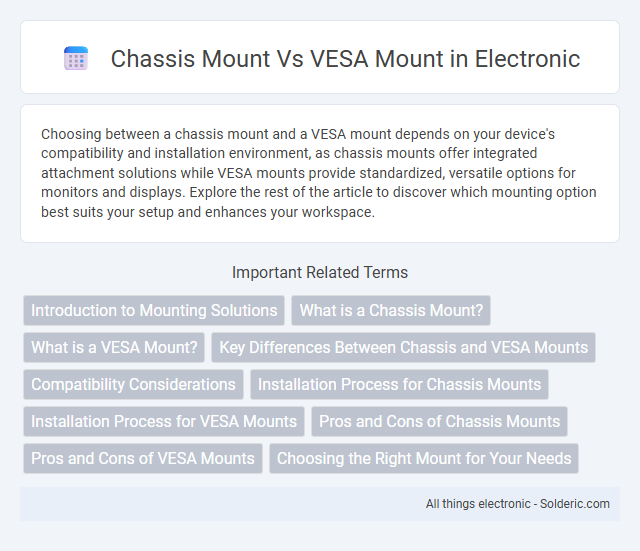Choosing between a chassis mount and a VESA mount depends on your device's compatibility and installation environment, as chassis mounts offer integrated attachment solutions while VESA mounts provide standardized, versatile options for monitors and displays. Explore the rest of the article to discover which mounting option best suits your setup and enhances your workspace.
Comparison Table
| Feature | Chassis Mount | VESA Mount |
|---|---|---|
| Mounting Standard | Custom OEM-specific chassis integration | Universal VESA standard (75x75mm, 100x100mm, etc.) |
| Compatibility | Limited to specific device models or brands | Compatible with most monitors and displays |
| Installation | Fixed, built-in during manufacturing or assembly | Modular, easy to install and remove |
| Flexibility | Low; designed for specific chassis dimensions | High; supports various mounting positions and swivel options |
| Use Case | Industrial equipment, embedded systems, servers | Consumer monitors, professional displays, workstations |
| Cost | Potentially higher due to custom design | Cost-effective and standardized |
| Durability | Robust; tailored to device environment | Durable but varies by mount model |
Introduction to Mounting Solutions
Chassis mount and VESA mount are two primary types of mounting solutions designed to secure electronic devices such as monitors and industrial equipment. Chassis mounts integrate directly to the device's frame, offering robust support ideal for heavy or specialized equipment, while VESA mounts conform to standardized hole patterns for versatile compatibility across most displays. Choosing the right mounting solution affects Your device's stability, space efficiency, and ease of installation.
What is a Chassis Mount?
A chassis mount refers to a method of securing electronic components directly to the frame or enclosure of a device, providing stability and reducing vibration. This type of mounting is commonly used in industrial and automotive applications where robust, durable attachment is essential. Chassis mounts typically involve brackets or fasteners designed to fit the specific dimensions and contours of the equipment's internal structure.
What is a VESA Mount?
A VESA mount is a standardized mounting interface defined by the Video Electronics Standards Association, designed to securely attach monitors, TVs, or other display devices to wall brackets or monitor arms. It specifies mounting hole patterns on the back of displays, typically measured in millimeters, such as 75x75 or 100x100 mm, ensuring compatibility across various brands and models. Understanding your device's VESA mount specifications can help you select the correct support solution and optimize your workspace ergonomics.
Key Differences Between Chassis and VESA Mounts
Chassis mounts attach electronic components directly to a device's frame, ensuring stability and compact integration, ideal for internal hardware setups. VESA mounts follow standardized dimensions, allowing easy attachment of monitors and displays to various mounts or arms, enhancing flexibility and ergonomic positioning. Your choice depends on whether secure internal housing or adaptable external mounting is prioritized for your equipment.
Compatibility Considerations
Chassis mounts offer compatibility primarily with custom enclosures and industrial hardware, making them ideal for rugged or specialized setups, while VESA mounts adhere to standardized hole patterns, ensuring broad compatibility across most monitors and TVs. VESA mount standards typically come in sizes like 75x75 mm and 100x100 mm, which simplifies the selection process for wall mounts, arms, and stands. Compatibility considerations should weigh the mounting environment and device specifications to ensure secure and optimal installation.
Installation Process for Chassis Mounts
Chassis mounts simplify the installation process by directly securing hardware components to the frame or chassis using pre-drilled holes and standardized mounting brackets. This method eliminates the need for external adapters, ensuring a stable and compact setup ideal for industrial and automotive applications. The straightforward attachment reduces installation time and enhances durability by minimizing vibration and mechanical stress on components.
Installation Process for VESA Mounts
The installation process for VESA mounts involves aligning the monitor or TV's standardized mounting holes with the VESA-compatible bracket, ensuring secure attachment using screws that match the mount's pattern, typically 75x75mm or 100x100mm. You must verify the compatibility of your display's VESA pattern before proceeding, as this guarantees a stable and precise fit. Proper installation requires mounting the bracket firmly to a wall or stand, effectively optimizing your workspace with improved ergonomics and flexibility.
Pros and Cons of Chassis Mounts
Chassis mounts offer robust structural support and secure integration within electronic enclosures, making them ideal for heavy or vibration-sensitive equipment. Their main drawback lies in limited flexibility and accessibility, often requiring disassembly for maintenance or adjustments. Compared to VESA mounts, chassis mounts provide superior durability but lack the modularity and ease of repositioning favored in versatile mounting scenarios.
Pros and Cons of VESA Mounts
VESA mounts offer a standardized, versatile solution for attaching monitors and TVs, ensuring compatibility across a wide range of devices and providing flexible adjustment options for improved ergonomics. They enable easy wall mounting, saving desk space and enhancing aesthetic appeal, but require proper support structures to handle the device weight safely. Limitations include potential complexity during installation and incompatibility with non-VESA compliant devices, which restricts their universal use.
Choosing the Right Mount for Your Needs
Choosing the right mount depends on your device compatibility and installation environment, where chassis mounts offer integrated support for specific hardware, ensuring secure attachment within equipment racks. VESA mounts provide versatility, accommodating a variety of monitors and displays with standardized hole patterns, ideal for adjustable setups and space-saving applications. Consider Your device dimensions, weight, and required mobility to determine whether chassis or VESA mounting best suits your needs for optimal functionality and convenience.
Chassis mount vs VESA mount Infographic

 solderic.com
solderic.com